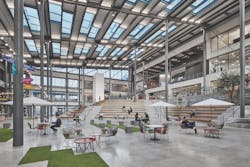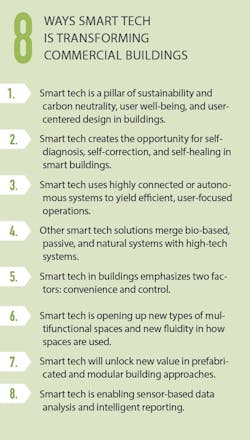Smart buildings take hold: 8 ways smart tech is transforming commercial buildings
Buoyed by a surge of high-tech innovations and several years of robust U.S. construction markets, AEC teams are working on ideas for “smart buildings.” Since the mid-1980s, a new generation of products, technologies, and analytical tools has transformed the building landscape. The benefits of “smart” technologies and operations for design, construction, and ownership/operations are now inescapable.
Prior to the 1990s, the notion of intelligent buildings focused on controls and automated processes for building operations, mainly in HVAC, lighting, and security systems, says Joachim Schuessler, Principal with Goettsch Partners. “Then, about 15 to 20 years ago, we started working on buildings that optimized controllability and comfort for the users,” he says. By the late 1990s, tools like building information modeling were making built projects a digital extension of the architectural/engineering and fabrication processes, with valuable impacts on downstream operations such as facility management.
The latest definitions of smart buildings embrace a much broader, more futuristic outlook. Schuessler and other experts describe the new paradigm as buildings and building portfolios created and operated using technology systems that aggregate data, make decisions, and continuously optimize operations with ongoing predictive feedback, including from building systems and occupants.
David Herd, Managing Partner with BuroHappold Engineering, asks: “Do the building’s design and systems anticipate programmatic change over time? Is it a ‘well’ building that helps keep people healthy? If it’s smart, today’s thinking goes, it can accomplish these goals, and more.”
Tech-enabled properties transcend time and place, too. “Smart buildings can also be defined as connected buildings,” says Marco Macagnano, PhD, Senior Manager, Lead: Smart Real Estate with Deloitte Consulting. They are “the product of an omni-channel approach focused on generating meaningful information to support decision making through data analysis.”
Connected systems should add practical value while protecting against hackers and other breaches. They can benefit O&M by tracking energy-use intensity (EUI) across multiple campuses or by alerting a facilities department that an escalator is in jeopardy of failing. Owners can use the cloud and the Internet to access existing systems to do more. Bring in the ability of Big Data to tap into worldwide reporting on facility operations, and building owners can suddenly identify patterns and trends that could lead to better design choices.
“The biggest difference with current smart buildings is that tech is the enabler of three primary pillars: sustainability and carbon neutrality, the well-being of users, and user-centered design,” says Jan-Hein Lakeman, Executive Managing Director of Edge Technologies and OVG Real Estate USA.
Lakeman cautions that smart systems alone can’t solve for big-picture, “holistic objectives” such as sustainability. Many are “just new versions of things already in wide use, such as the sensors used to digitize information from energy meters, which utility companies have had for years.”
But the truly smart buildings of today offer potential capabilities that are self-diagnosing, self-healing, and self-correcting. They tell owners and developers what’s needed. They ensure that occupants are cared for, even as occupancies change. And if something’s not working, an intelligent building can sound alarm bells.
FINDING SMART PROJECTS
If smart buildings are so great, who’s building them? What goes into them, and how are they performing?
Currently, only a handful of businesses and owner-operators could be said to be running truly smart buildings. Projects like The Edge in Amsterdam and PNC Tower in Pittsburgh point in the right direction. Others are showing how new technology approaches contribute to high-performance, energy-efficient, healthy, and productivity-focused environments.
Some built solutions use highly connected or autonomous systems with predictive capabilities, yielding highly efficient, occupant-focused operations that offer an edge in the market. Others merge bio-based, passive, and natural systems with high-tech systems, notably the ISTB-7 research center conceived by Studio Ma for Arizona State University, with its planted atrium, and the Santa Monica (Calif.) City Services Building, designed by BuroHappold and architect Frederick Fisher and Partners to meet Living Building Challenge criteria.
These projects share a number of smart building elements of high value today. A baseline setup could include next-generation building automation systems and controls interconnected throughout their MEP systems, often with façade integration, as well as combined lighting and daylighting. Building- and portfolio-wide controls should integrate with occupancy sensors and personalization tools designed to boost efficiency and occupant productivity.
These systems are cloud-based and IoT-connected for enterprise-wide access, with predictive and preventive technologies, such as smart O&M software, linked to field sensors with built-in edge computing capacities. Robotic actuators and self-maintained systems, such as leak detection sensors and automatic-shutoff water valves, automate routine tasks.
“Most discussions of smart buildings today focus on data collection and user customization,” says Paul De Santis, LEED AP, Partner with Goettsch Partners. “The data is mostly derived from enhanced sensoring, while the customization is driven through new mobile technology interfaces.”
De Santis says project teams are already witnessing the impacts on building operations through staff reductions and better energy performance. “But I think owner/developers have yet to capitalize on the financial and marketing potential of smarter buildings,” he says.
The watchwords for specifying smart are “convenience and control,” says Herbert Els, SVP, Building Technology Systems with WSP USA. The firm’s own smart showplace, a new innovation center in Boulder, Colo., employs heat mapping for access control and occupancy monitoring; power consumption is monitored at the business unit level. Tied into automated room reservation systems and the building’s lighting and environmental controls, all the smart features are linked and accessed via a mobile platform for direct occupant feedback and security reporting.
TOO SMART FOR YOUR OWN GOOD?
The openness and potential vulnerability of smart building concepts like IoT and remote operations do raise concerns among experts. Naysayers point to cyber-security breaches at power plants and data centers. Privacy protection may also be at risk.
One of the advantages of smart buildings should be to protect project teams from errors and warn owner-operators of possible hacks or intrusions. Effective smart buildings, the theory goes, should also point out factors that could influence capital planning, such as the need to elevate concrete transformer pads to enhance operational resiliency.
Smart buildings should impact retrofit planning by analyzing MEP performance across, say, an entire hotel chain, helping the operator budget for replacing packaged thermal A/C systems.
With IoT and Big Data supporting smart buildings, portfolio-wide analysis and control will have the potential to boost the performance of tenants. A new class of external applications make it possible to access building system and device-level information—many using existing products and sensors, with no add-ons necessary—thanks to IoT, which “mitigates barriers of time and place,” says David M. Fisher, President of PolarSoft, which creates building control and communication programs using the BACnet protocol.
Some project teams are using new analytics platforms like SkySpark and CopperTree, which not only collect device-level data but also interpret what’s important for new facility designs and operations. These initiatives impact individual enterprises and have also spawned open-source efforts such as Project Haystack to streamline the flood of IoT data available for easier, almost instantaneous value creation.
It adds up to more strategic facility usage. Franchise operators and companies like WeWork—which buys, builds, and manages coworking locations—are trying to leverage these smart building tools to manage their properties. WeWork routinely accesses real-time data on coworking locations to monitor occupancy levels, air quality, and O&M tasks from a central location. In this way, leaders can direct facilities with higher-level goals—using a new or existing installed base for data mining, maintenance, optimization, and planning. Smart systems drive building processes and upgrades as well as property portfolio decisions.
WIRELESS PRODUCTS AND SYSTEMS
When it comes to smart building systems, connectivity and interaction are critical. The route to performance optimization is twofold: first, improve the operational function of the facility; second, enhance the experience and productivity of the people in the building.
What sets today’s components apart are such capabilities as enhanced data generation and analysis and IoT-enabled reporting and communication. Project teams who leverage these capabilities are finding advantages that play out across a range of building systems and components, from lighting fixtures and HVAC sensors to distributed antenna systems and location services using Bluetooth beacons and sensors.
A common thread running through these product innovations is the role of what architect Thom Mayne has called “the two-fer,” where the product serves a building operations function while also gathering information and sharing it across building networks.
Another theme is distributed remote operations. As Richard Baker, Project Designer in Stantec’s Information & Communication Technology Group, says, “Project teams need to understand wireless communication and IoT devices to make the most of smart technologies.”
The latest technology is power-over-Ethernet LED lighting, says Matthew Odell, Director of Technologies with the S2N consulting group at Clark Construction. “PoE” uses as little as 24 volts versus a more standard 177 volts. And because PoE lighting is connected to the building’s network, you can add Bluetooth and occupancy sensors to collect data and track energy savings, he says.
A related innovation: light-fidelity (LiFi) networks, which employ LED lighting to transmit and receive data in a secure environment, without the bandwidth limitations of radio-spectrum WiFi.
As converged networks combining voice, video, and data replace typical distributed networks, sensor-based data analysis and intelligent reporting are becoming more common. These tools make it easier for building management systems to influence areas where conditions affect productivity and occupant safety, says Deloitte’s Macagnano.
He says this opportunity is being activated in large part by the growth of edge computing, a technique where building sensors and devices—those out on the “edge” of the network—can analyze and process information, sending only what is required to building operators and owners. “This approach improves data security and reduces requirements for a central platform,” he says.
Air-conditioning manufacturers such as Mitsubishi Electric Trane HVAC US are incorporating AI into indoor units to enable their systems to automatically optimize conditioning and airflow based upon the location of occupants, outdoor temperature, and other variables, says Michelle Robb, Director of Marketing. Short term, these advances promise lower operating costs. Down the line, advanced built-in microprocessors will enable the equipment to communicate operational status, perform self-diagnostics, and provide alerts to facility management teams when specific anomalies are found, says Robb.
WISER BUILDING TYPES, TOO
Occupant-responsive, real-time adjustment of building environments continues to expand into new arenas. At the Museum of the Bible in Washington, D.C., Clark Construction and architect SmithGroup incorporated a proprietary real-time location system that tracks patrons via a tablet-size device and a series of anchors and sensors as they move between exhibits, turning on lights and video players as necessary.
In addition to enhancing wayfinding and security, the system can tell which way occupants are facing, where they are standing (within inches), and which exhibits they have visited, so that follow-up emails can be sent to encourage repeat visits.
Experts agree that the trajectory points toward even more intelligent and responsive buildings. The incorporation of AI and machine learning—and the emphasis on interoperability—create opportunities for a facility to tune itself to changes in working conditions.
“As the built environment increases its ability to adapt to occupants, we might see new types of multifunctional spaces and new fluidity in how spaces are used,” says Robb. “That opens up opportunities for architects to design buildings in fresh configurations we haven’t seen before.”
See Also: Investing — and building — smarter
Analysis of facility data from existing structures can guide project teams in optimizing space use. Hospitals, large employers, and collaborative workspace providers like WeWork are collecting post-occupancy data from their property portfolios and adjusting the next project’s parameters to suit.
“At our Edge building for Deloitte in Amsterdam, post-occupancy data analysis showed that we could have taken out half of the mechanical space for the same performance level,” says Edge Technologies’ Lakeman. “This data helps make the next building better by showing us how to achieve huge space and cost savings that drastically improve leasability, along with how we can optimize and make smaller, smarter buildings.” His firm’s own global headquarters in Amsterdam, Edge Olympic used lessons from Deloitte to create a building with equal functional capacity at roughly one-quarter the former size. “If you’re active in inner-city environments,” Lakeman says, “you have to think about how to use space in the most efficient way.”
Other experts anticipate that as faster, 5G networks—the fifth generation of cellular mobile communications with greater bandwidth—bring higher transmission speeds to urban centers, intelligent systems will quickly become scalable. New building uses and possibly even new typologies are possible, says Goettsch Partners’ De Santis. “I believe these changes will drastically impact sectors related to transit, healthcare, and education,” he explains.
In this way, smart buildings could transcend traditional roles as brick-and-mortar entities, speaking to each other and to larger urban systems, says Kurt Emshousen, Chief Administrative Officer with real estate firm Transwestern. “The facilities most likely to benefit from smart technology are generally multitenant buildings or a complex where the tenants are high-tech users looking to connect to services in the neighborhood, or where access to information outside their internal systems is necessary for operations,” says Emshousen.
Similarly, as Stantec’s Baker points out, “Smart buildings are one of the major foundations in the smart city movement now under way.” Studies such as McKinsey Global Institute’s “Smart Cities: Digital Solutions for a More Livable Future,” published last June, describe smart buildings and smart cities operating on the same IoT-based technology backbone.
SMARTER MATERIALS AND SOLUTIONS
Greater use of intelligent sensors and subsystems will unleash greater use of data and unlock market advantages.
Consider the use of control algorithms for high-speed elevators in new high-rise buildings. After a decade or so on the market, these systems have become the standard for Class A office buildings. The growth of smart networked occupancy sensors will similarly become an expected feature of the best commercial and institutional facilities.
Smart building growth may also unlock new value in prefabricated and modular building approaches, with companies like Katerra installing smart tech in the manufacturing environment for plug-and-play application in the field. Smart tech and robotics also undergird the new multistory warehouses and factories in planning, according to experts at JLL. At the Brooklyn Navy Yard in New York City, new concepts for vertical manufacturing buildings by WXY Studio show how technologies for buildings, transportation, industrial processes, and smart cities are converging in unique and valuable ways.
Will these trends lead to new kinds of building expression and radically new solutions? Perhaps. The recently built Cubico project designed by RKTB Architects at 433 Broadway in Manhattan’s Soho district delivers a ground-up solution specifically engineered for its unique coworking occupancy. The chic white metal building is loaded with all the hot buttons—floor-to-ceiling windows, flexible office setups, and a modern riff on the Soho historic district’s classic loft façades. What makes 433 Broadway uniquely intelligent is its integrated smarts, plug-and-play utilities, and interior systems, and flexible floor plates.
These features, merging long-standing and futuristic concepts into a showcase of design and construction excellence, add today’s most desirable smart building features: convenience and control.




